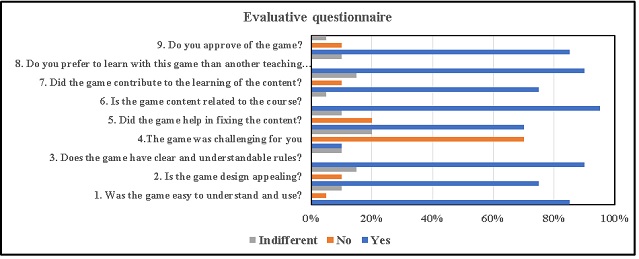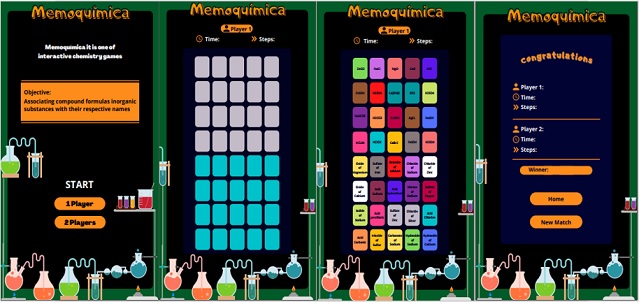Autores
Santos, I.F. (IFTO CAMPUS PARAÍSO DO TOCANTINS) ; Viroli, S.L.M. (IFTO CAMPUS PARAÍSO DO TOCANTINS) ; Rosa, T.O. (IFTO CAMPUS PARAÍSO DO TOCANTINS) ; Farias, I.M.R. (IFTO CAMPUS PARAÍSO DO TOCANTINS) ; Candido, B.A.R. (IFTO CAMPUS PARAÍSO DO TOCANTINS) ; Alves, T.T. (UFT CAMPUS GURUPI) ; Lança, A.C. (UFT CAMPUS GURUPI)
Resumo
Information and Communication Technologies - ICT can enhance pedagogical
practices by adding access to information, flexibility, diversity of supports in
their treatment and presentation. The study evaluated a virtual memory game
developed with the PowerPoint tool for teaching the nomenclature of inorganic
functions. The game was applied to 40 students of the 1st year of Education. The
research was carried out with the division of the class into pairs and the game
for each pair. After the application of the game, an evaluative questionnaire
was applied. The game presented a contribution to learning and approval for the
game developed with the Microsoft PowerPoint program can become a differential
and contribute to the quality of teaching content on the nomenclature of
inorganic functions.
Palavras chaves
Chemistry teaching; Gamification; Powerpoint
Introdução
Chemistry is a natural science present in the daily life to which the student is
exposed, food, health, beauty, clothing etc, and most of the time he does not
even realize it (DIONIZIO, 2018). Despite this, even in the face of the
importance of this science for society, it is perceived in some school
environments, a precarious teaching, applied in the memorization of contents,
with the mere exposition of formulas, laws and concepts, and with repetitive
exercises resolutions, which does not contribute to the development of
meaningful learning (CRISÓSTOMO et al, 2018). Thus, it is necessary to insert
new teaching methodologies in the educational environment that enable quality
education. Information and Communication Technologies (ICT) can enhance
pedagogical practices, adding access to information, flexibility, diversity of
supports in their treatment and presentation (SOUSA, 2021). The use of ICTs in
the teaching of Chemistry represents an alternative for the study of contents
that are poorly understood in theory, and without being developed in practical
classes (CRISÓSTOMO et al, 2018). Games stand out as a viable option for science
teaching, as it is a great pedagogical strategy, with engaging language, where
various skills are learned (LEÃO et al, 2019). The new ICTs offer the education
system new resources and programs. Microsoft PowerPoint is a program used for
creating, editing and displaying graphic presentations that can become an
educational object with a great differential for the teaching and learning
process. Faced with the need to introduce new technologies into teaching, this
study evaluated a virtual memory game developed with the PowerPoint tool for
teaching the nomenclature of inorganic functions.
Material e métodos
The study was carried out in an exploratory and descriptive way with the
intention of evaluating a virtual memory game "Memochemistry " developed with
the Microsoft PowerPoint program for teaching inorganic functions with a focus
on the study of the molecular formulas of inorganic compounds to aid knowledge
and fixation the content exposed by the teacher on inorganic functions (acids,
bases, salts, oxides and hydrides). The game was developed by students of the
3rd period of the Degree in Chemistry in cooperation with students of the 6th
period Information System Course of the Instituto Federal do Tocantins Paraíso
do Tocantins campus. The game was applied to 40 students from the 1st year of
High School Integrated to the Environmental Technician Course in June 2022 who
study at the same institution and campus. The research was carried out with the
division of the class into pairs, delivery of a table on a sheet of bond paper
containing the names of anions and cations to help students during the game,
explanation of the rules of the game, which are identical to the rules of the
traditional memory game and the Memochemistry game for each pair. After the
application of the game, an evaluative questionnaire was applied with 9 closed
questions: 1. Was the game easy to understand and use? 2. Is the game design
appealing? 3. Does the game have clear and understandable rules? 4.Was the game
challenging for you? 5. Did the game help in fixing the content? 6. Is the game
content related to the course? 7. Did the game contribute to the learning of the
content? 8. Do you prefer to learn with this game than another teaching method?
9. Do you approve of the game? so that the students could evaluate the game.
Resultado e discussão
Graph 01 informs the students' answers in relation to the evaluative
questionnaire applied to the students to find out about the use of the
Memochemistry game. Figure 2 represents the stages of the Memochemistry game.
According to the results presented in the graph, it is observed that the
Memochemistry game 85% was easy to understand and use by students (85%),
presented an attractive design (75%), clear and understandable rules (95%), not
presented a challenging character (70%), helped in fixing the content (70%), the
content of the game was related to the subject (95%), the game contributed to
the learning of the content (75%), the students preferred to learn with this
Memochemistry game than with another teaching method (90%) and approved the game
(85%). The game produced and applied showed satisfactory results in all
questions asked, except for the challenging question. The absence of phases or
stages must have influenced the students' opinion regarding the challenging
nature of the game. Crisóstomo et al, 2018 also performing analysis of the game
produced in Microsoft Power Point obtained consistency in all the responses of
the students participating in the research with the pedagogical quality of the
game, Siqueira et al (2019) using Power Point developed a work where 90% of the
participants students agreed that the features are good and 95% thought the game
looked good. Segantini (2014) in his study states that 58% of teachers use
PowerPoint to present the desired content. The authors Pires, Araujo-Jorge e
Trajano (2012) state that 55% of the students have already had contact with
PowerPoint in class and 62.3% of the opinions about the use of this software
were classified as: good, it facilitates the understanding and the use of images
as facilitators of learning


Conclusões
In view of the answers obtained through the evaluative questionnaire, it was
possible to conclude that the Memoquímica virtual game presented ease of
understanding and use by the students, attractive design, relationship with the
discipline contributing to the learning of the content and great approval for the
game developed with the Microsoft program. PowerPoint can become a differential
and contribute to the quality of teaching content on the nomenclature of
inorganic functions.
Agradecimentos
To God, to the IFTO Paraíso do Tocantins campus
Referências
CRISÓSTOMO, L. C. DA S.; MARINHO, M. M; MARINHO, G. S; MARINHO, E. S. Avaliação de um jogo pedagógico desenvolvido com o powerpoint para o ensino de química. 23º Seminário Internacional de Educação, Tecnologia e Sociedade. v. 7 n. 1. P. 1-10. 2018. Disponível em: https://seer.faccat.br/index.php/redin/article/view/1067. Acesso em: 12 abr. 2022.
DIONÍZIO, T. P. “Uno da Química”: conhecendo os elementos químicos por meio de um jogo de cartas. Revista Educação Pública, Rio de Janeiro, v. 18, nº 14. 2018. DOI: 10.18264/REP Disponível em: https://educacaopublica.cecierj.edu.br/artigos/18/14/ldquo-uno-da-qumica-rdquo-conhecendo-os-elementos-qumicos-por-meio-de-um-jogo-de-cartas. Acesso em: 12 abr 2022.
LEÃO, M.F.; FANTINELL JÚNIOR, M.; COSTA, A.N.S.; ALVES, A.C.T. Jogos didáticos no ensino de ciências: maneira diferenciada de ensinar e aprender sobre poluição. In: CONGRESSO BRASILEIRO DE QUIMICA, 59., 2019, João Pessoa. Anais Eletrônicos [...]. João Pessoa, 2019. Disponível em: http://www.abq.org.br /cbq/2019/trabalhos/5/956-27759.html. Acesso em: 21 maio 2022.
PIRES, F.E.S.S.; ARAUJO-JORGE, T.C.; TRAJANO, V.S. Avaliação sobre o uso do programa PowerPoint em sala de aula por estudantes da educação básica na rede pública. Revista Brasileira de Ensino de Ciência e Tecnologia, v.5, nº1. 2012. Disponível em: https://periodicos.utfpr.edu.br/rbect/article/view/862. Acesso em: 12 mar. 2022
SEGANTINI, J.H. Uso das tecnologias na sala de aula, como ferramenta pedagógica e seus reflexos no campo. 32f. [Especialização]. Universidade Federal do Paraná, Foz do Iguaçu, 2014. Disponível:https://acervodigital.ufpr.br/handle/1884/50327. Acesso em: 13 abr. 2022
SIQUEIRA, A.C.O.; FUJIHARA, R.T.; ROCHA, E.S.; FREIRE, M.J. Todos contra a dengue: um jogo interativo produzido em PowerPoint. Educação Pública, v.19, nº27, 29 de outubro de 2019. Disponível em: https://educacaopublica.cecierj.edu.br/artigos/19/27/todos-contra-a-dengue-um-jogo-interativo-produzido-em-powepoint. Acesso em: 14 maio 2022.
SOUSA, M. A. de C. TICS: O uso de aplicativos móveis no ensino de Química Urutaí, 2021. 39 p. TCC (Graduação em Licenciatura em Química) –Instituto Federal Goiano, Urutaí, 2021. Disponível em: https://repositorio.ifgoiano. edu.br/bi tstream/prefix/1735/1/tcc_Maria%20Aparecida%20de%20Castro%20Sousa.pdf. Acesso em: 3 abr. 2022
















